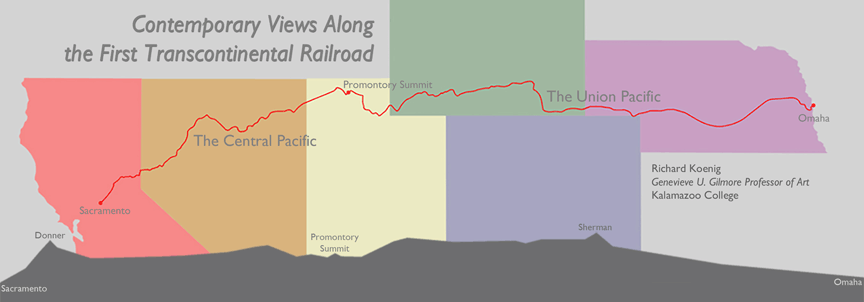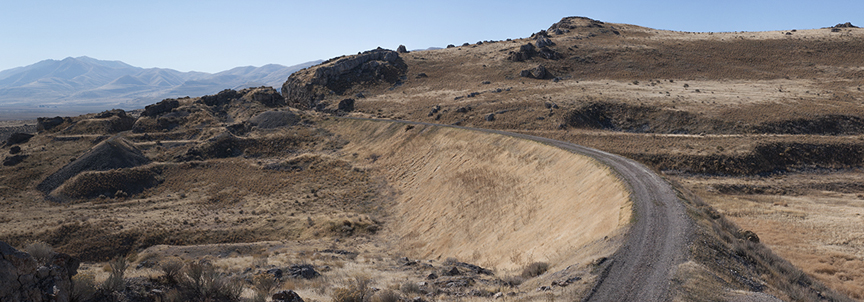With initial support from the Great Lakes Colleges Association New Directions Initiative, along with continuing support from Kalamazoo College, I made (between the years 2010 and 2018) a comprehensive series of landscape photographs along the historical route of the first transcontinental railroad. My topic combines the history and tradition of western landscape photography with the subject being the original route of the Union Pacific and Central Pacific railroads upon completion.
Statement While construction of the Pacific Railroad ostensibly began during the Civil War, it was not until that great conflict was over that it really got rolling. In a race for government subsidies and land grants, the Central Pacific built eastward from Sacramento, California, while the Union Pacific built westward from Omaha, Nebraska. The two railroads met at Promontory Summit, just north of Great Salt Lake, Utah Territory, on May 10th 1869. It was a watershed moment. I follow in the footsteps of photographers Alfred A. Hart and A. J. Russell who expertly recorded the construction of the road. But this is not a re-photography project—it is, rather, photography as archaeology. In making a comprehensive series of photographs along the original route, my goal is to give the viewer as strong of a connection as possible to this 19th century engineering marvel through the remaining visual evidence of the human-altered landscape. And while not visible, I also hope to evoke the various peoples involved with the railroad, as well as those affected by it. I have always been drawn to western landscape photographs, particularly the work of Carleton Watkins and Timothy O’Sullivan. I tend to see their imagery as existing on opposite sides of an aesthetic coin—with the former rendering the beautiful and the latter portraying the sublime. These two 18th century linguistic terms, beautiful and sublime (usually considered in relation to one another), were used to categorize one’s emotional response when viewing artwork. Imagery that promoted pleasurable and familiar feelings was referred to as beautiful, while pictures that evoked feelings of awe or terror, often brought on by the immense scale of nature, were referred to as sublime. The story of the first transcontinental railroad is one of contradictions and oppositional forces not unlike the conceptual interrelatedness of those two aesthetic terms. The surveyors explored an Eden, but initiated its destruction. The road was a crown jewel of the industrial age, but the actual building, the grading and tunneling, was done almost completely without machines. The railroad conquered time and space, but this led quickly to the decimation of the American bison which pushed the people who depended upon them to the brink. This was the first transcontinental railroad in North America, or anywhere for that matter. The pounding of the Golden Spike signaled the completion of a great human achievement, but it must have sounded like a death knell to Native Americans. It put a bow on Manifest Destiny and served as a primer for the questionable business practices that would follow in the Gilded Age. In the end, I want these images to be a pictorial accompaniment to well-established textual histories of the building of the railroad, the foremost being David Haward Bain’s Empire Express. His book tells the complete tale, but when I’m in the field I most often think of the people who built the line with their hands and their backs—primarily the Chinese, who performed so well for the Central Pacific, and the Irish, who toiled proudly for the Union Pacific. The railroad is still active over much of the route—which was preceded by pioneer trails, joined by the Lincoln Highway, and eventually succeeded by Interstate 80 and air travel. While I have photographed along much of the line, I tend to linger where the steel has been pulled up, those portions of the line that has been abandoned for a less steep or curvy alignment. I enjoy the calm of those deserted areas most—through modern absence, I find it most easy to imagine a 19th century presence. Richard Koenig, Genevieve U. Gilmore Professor of Art, Kalamazoo College  See forty web-based images here from across the route—from west to east. Download a PDF with thirty-five portfolio images with extended captions. close window |